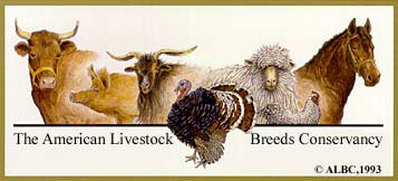Here at White Mountains Ranch we focus on heritage breed livestock. “Heritage” breeds are simply the older breeds that developed and thrived on old time farms and ranches. Traditionally, farmers throughout the world have raised thousands of different animal breeds and plant varieties, and most of these heritage breeds were common on small farms before the age of industrialized operations. Heritage breeds are the traditional livestock breeds that were raised by farmers in the past, before the drastic reduction of breed variety caused by the rise of industrial agriculture that started in the 1940's.
Farmers developed different breeds of livestock based on their environment and needs, and these heritage animals were bred over time to develop traits that made them particularly well-adapted to those local environmental conditions. Heritage breeds are better adapted to withstand disease and survive in harsh environmental conditions, and their bodies can be better suited to living on pasture (grass), rather than on the concentrated grains used today. Additionally these heritage breeds have much better mothering instincts and are much more self prolific than an industrialized breed.
These livestock breeds also serve as an important genetic resource, and when heritage breeds become extinct, their unique genes are lost forever and can’t be used to breed new traits into existing livestock breeds. Therefore, by raising heritage livestock breeds, sustainable farmers not only maintain variety within livestock populations, they also help to preserve valuable traits within the species so that future breeds can endure homesteading conditions.
Today's Agriculture: In the 1940's factory farming became popular. Factory farming is the process of raising livestock in confinement at high stocking density. The main products of this industry are meat, milk and eggs for human consumption. The first animals to be factory farmed were chickens. The discovery of vitamins and their role in animal nutrition led to vitamin supplements, which allowed chicken to be raised indoors. Then the discovery of antibiotics and vaccines facilitated raising livestock in larger numbers by reducing disease. In the 1960's pigs and cows began to be raised on factory farms. In 2005 factory farming accounted for 40% of world meat production. {Factory Farming Wikipedia}
Livestock breeds used in industrial agriculture are bred to produce lots of milk or eggs, gain weight quickly, or yield particular types of meat within confined facilities. Since the majority of livestock today is raised in Concentrated Animal Feeding Operations (look up that word if you want an eye-opener) producers have bred for qualities enabling them to grow faster and larger in horrible conditions with no regard to mothering instincts, health, etc. But these commercial breeds have not been selected to maintain important traits such as ability to forage, longevity, tolerance to extreme cold or heat, predator avoidance and broodiness or mothering instincts. You are much more likely to find these valuable qualities in a heritage breed.
CAFOs, otherwise known as “factory farms,” are all about raising farm animals faster, bigger, cheaper. To sustain their unnaturally concentrated and large populations of livestock, CAFOs rely heavily on antibiotics and other unnatural compounds.
In the US, only a few main "commercial" breeds dominate the livestock industry:
To be listed in the American Livestock Breed Conservancy, the following criteria apply:
● Critical: Fewer than 200 annual registrations in the United States and estimated global population less than 2,000.
● Threatened: Fewer than 1,000 annual registrations in the United States and estimated global population less than 5,000.
● Watch: Fewer than 2,500 annual registrations in the United States and estimated global population less than 10,000. Also included are breeds that present genetic or numerical concerns or have a limited geographic distribution.
● The breed is a true purebred genetic breed (when mated together, it reproduces the breed type).
● It must have had an established and continuously breeding population in the United States since 1925.
Fortunately, a growing number of sustainable farmers are preserving agricultural variety and protecting biodiversity by raising “heritage” or “heirloom” animal breeds and crops. As agricultural practices change to meet the increasing demands of the future, the genetic diversity and qualities of the older breeds become more and more important.
Here at White Mountains Ranch we focus on the rare old heritage breeds and help preserve the genetics and save them from extinction. We are a small ranch and can only do so much, but there is a growing number of dedicated farmers and ranchers that are focused on saving these heritage breeds of livestock.
Farmers developed different breeds of livestock based on their environment and needs, and these heritage animals were bred over time to develop traits that made them particularly well-adapted to those local environmental conditions. Heritage breeds are better adapted to withstand disease and survive in harsh environmental conditions, and their bodies can be better suited to living on pasture (grass), rather than on the concentrated grains used today. Additionally these heritage breeds have much better mothering instincts and are much more self prolific than an industrialized breed.
These livestock breeds also serve as an important genetic resource, and when heritage breeds become extinct, their unique genes are lost forever and can’t be used to breed new traits into existing livestock breeds. Therefore, by raising heritage livestock breeds, sustainable farmers not only maintain variety within livestock populations, they also help to preserve valuable traits within the species so that future breeds can endure homesteading conditions.
Today's Agriculture: In the 1940's factory farming became popular. Factory farming is the process of raising livestock in confinement at high stocking density. The main products of this industry are meat, milk and eggs for human consumption. The first animals to be factory farmed were chickens. The discovery of vitamins and their role in animal nutrition led to vitamin supplements, which allowed chicken to be raised indoors. Then the discovery of antibiotics and vaccines facilitated raising livestock in larger numbers by reducing disease. In the 1960's pigs and cows began to be raised on factory farms. In 2005 factory farming accounted for 40% of world meat production. {Factory Farming Wikipedia}
Livestock breeds used in industrial agriculture are bred to produce lots of milk or eggs, gain weight quickly, or yield particular types of meat within confined facilities. Since the majority of livestock today is raised in Concentrated Animal Feeding Operations (look up that word if you want an eye-opener) producers have bred for qualities enabling them to grow faster and larger in horrible conditions with no regard to mothering instincts, health, etc. But these commercial breeds have not been selected to maintain important traits such as ability to forage, longevity, tolerance to extreme cold or heat, predator avoidance and broodiness or mothering instincts. You are much more likely to find these valuable qualities in a heritage breed.
CAFOs, otherwise known as “factory farms,” are all about raising farm animals faster, bigger, cheaper. To sustain their unnaturally concentrated and large populations of livestock, CAFOs rely heavily on antibiotics and other unnatural compounds.
In the US, only a few main "commercial" breeds dominate the livestock industry:
- 60 percent of beef cattle are of the Angus, Hereford or Simmental breeds.
- 75 percent of pigs in the US come from only 3 main breeds.
- Over 60 percent of sheep come from only four breeds, and 40 percent are Suffolk-breed sheep.
- 83 percent of dairy cows are Holsteins, and five main breeds comprise almost all of the dairy herds in the US.
- 99 percent of all turkeys raised for Thanksgiving are the commercial broad breasted turkey.
To be listed in the American Livestock Breed Conservancy, the following criteria apply:
● Critical: Fewer than 200 annual registrations in the United States and estimated global population less than 2,000.
● Threatened: Fewer than 1,000 annual registrations in the United States and estimated global population less than 5,000.
● Watch: Fewer than 2,500 annual registrations in the United States and estimated global population less than 10,000. Also included are breeds that present genetic or numerical concerns or have a limited geographic distribution.
● The breed is a true purebred genetic breed (when mated together, it reproduces the breed type).
● It must have had an established and continuously breeding population in the United States since 1925.
Fortunately, a growing number of sustainable farmers are preserving agricultural variety and protecting biodiversity by raising “heritage” or “heirloom” animal breeds and crops. As agricultural practices change to meet the increasing demands of the future, the genetic diversity and qualities of the older breeds become more and more important.
Here at White Mountains Ranch we focus on the rare old heritage breeds and help preserve the genetics and save them from extinction. We are a small ranch and can only do so much, but there is a growing number of dedicated farmers and ranchers that are focused on saving these heritage breeds of livestock.
Heritage Breeds we raise here at White Mountains Ranch:
Coming Soon:
Heritage Narragansett Turkey
Heritage Silver Appleyard Ducks
Heritage Speckled Sussex
Heritage Buckeye
Heritage Russian Orloff
Heritage Silver Appleyard Ducks
Heritage Speckled Sussex
Heritage Buckeye
Heritage Russian Orloff
If you are interested in learning more about heritage breeds or how you can help, please visit the American Livestock Breeds Conservancy.



